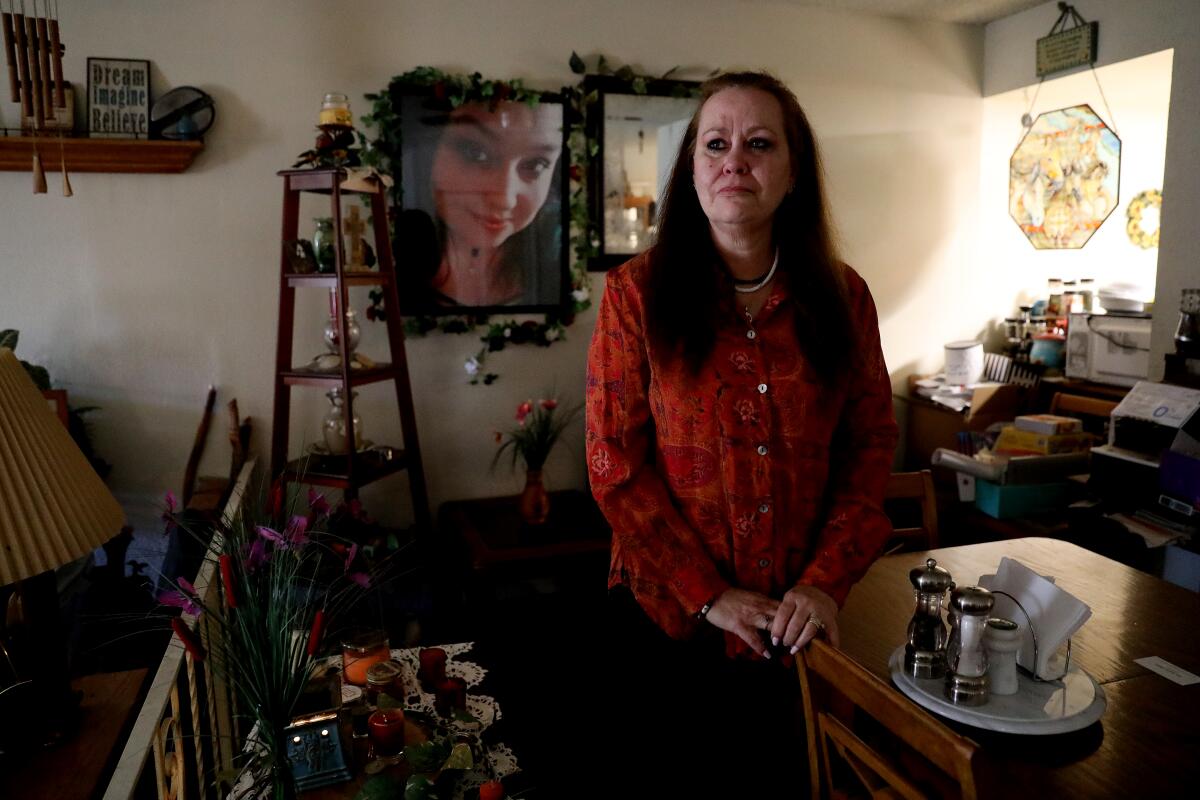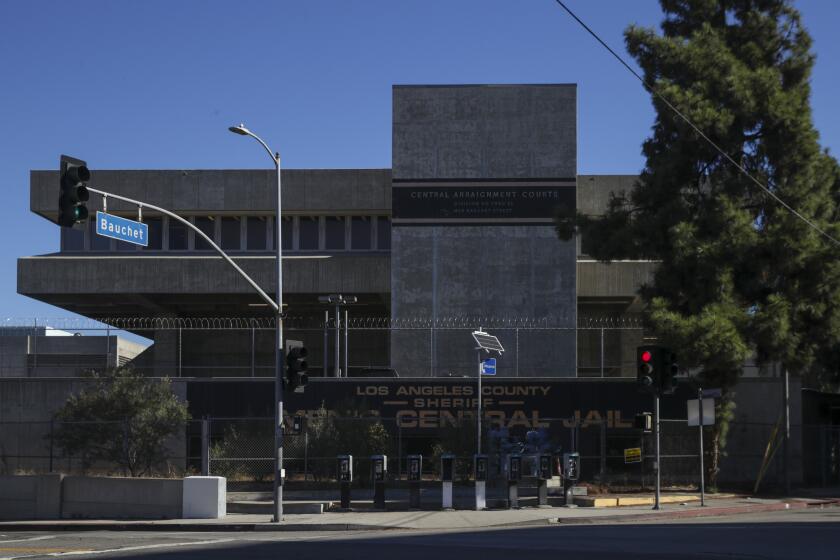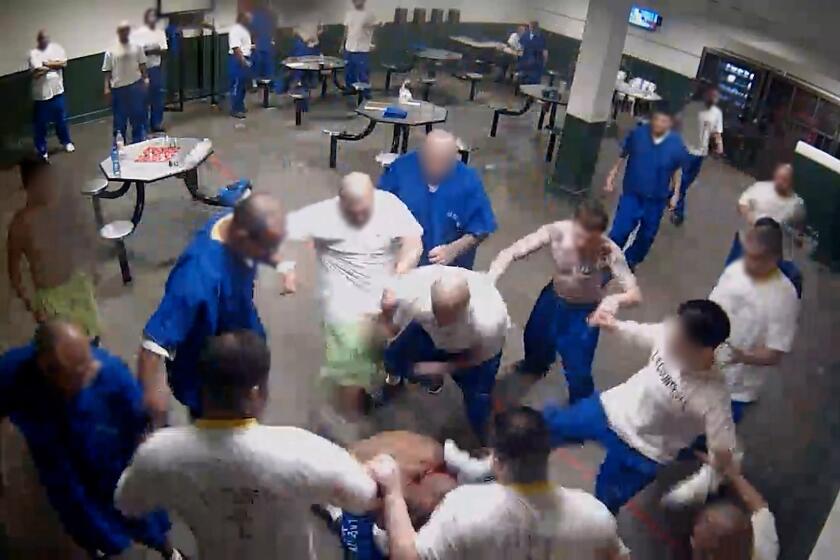A woman was jailed for shoplifting. Weeks later, her mother got back a decaying corpse

- Share via
Melinda Bettencourt was still in her nightgown when the police showed up at the door. It was a slow Saturday morning last fall, but her heart raced when she heard the uneasy tone in the officer’s voice.
The Fresno woman knew her youngest daughter, Amanda Bews, had been struggling for years. After battling a painful nerve condition, the 29-year-old started using drugs and had taken to living on the street. Eventually Bettencourt lost track of her. So when men with badges showed up at her home, Bettencourt feared she knew why — and she was right.
Bews had been arrested on a pair of misdemeanor charges, and died in a Los Angeles County jail two days later. But the officer who showed up at her door couldn’t tell Bettencourt anything about how her daughter died.
And a few weeks later, no one could explain what had happened to the rotting body Bettencourt saw at the funeral home.
“She looked like she was mummified,” Bettencourt told The Times, describing the “horrible” shock of watching bugs hover around her dead daughter’s face as a foul stench emanated across the room.
Even the pictures are gruesome: A side-shot of a face so bloated with death it’s gone flat. A close-up of skin, one patch bloodied and another so decayed it’s turned gelatinous. Part of the nose is missing, and the features are bloated beyond recognition.
When Bettencourt saw what was left of her daughter, she screamed.
“I couldn’t believe it was my baby,” she said.
Earlier this month, after more than a year of looking for answers, San Diego-based attorneys Lauren Williams and Timothy Scott filed a lawsuit against county officials, jail medical providers and the funeral home that handled Bews’ body.
“Folks whose family members die in custody are often waiting months for information about how their loved ones passed away. And even when they do find out from an autopsy, the answers are still vague — and that’s what we see here,” Williams told The Times.
Masoud Rahmati’s death after an apparent pre-dawn beating has renewed concerns about supervision in L.A. County jails, which have seen at least three homicides this year.
“We see a lot of facts consistent with the county failing to treat a case of alcohol withdrawal, but no one is accepting responsibility and calling it what it is,” she said. “And the same is true about any questions the family has about how and why Amanda’s body decomposed to the extent it did.”
Citing pending litigation, the medical examiner’s office declined to comment. Both the funeral home and jail medical providers did not respond to emails this week. And the Sheriff’s Department sent a general statement, but did not address several specific questions about the case.
“Any loss of life is tragic, especially those who are within our custody and care,” the statement said. “The Department takes every in-custody death seriously and strives to make every effort possible to prevent similar deaths in the future.”
It was in her early 20s that Bews really started drinking. By that point, she had a husband and two children and, according to her mother, “nobody could really figure out why” her life took such a turn. But it was right around the same time her medical problems started.
At first, Bews complained of pain in her feet and ankles, but the problem grew steadily worse. For months, doctors couldn’t figure out why, until a spinal tap revealed she had Guillain-Barré syndrome, a rare autoimmune disorder that causes the body to attack its own nerves, leading to tingling, weakness and pain.
Sometimes, her mother said, Bews couldn’t walk or take care of herself. Then during a hospital stay, she was prescribed painkillers. Soon, she turned from prescription pills to heroin and alcohol. Eventually, she stopped coming home.
“She just didn’t want to subject her kids to this,” Bettencourt said. “She was embarrassed.”
By the time Bews got arrested, her mother hadn’t heard from her for three years. It was Sept. 7, 2022, and court filings show that sheriff’s deputies had picked her up in Santa Clarita for allegedly shoplifting at a BevMo. During her arrest, records show, she admitted to using heroin and said she’d been drinking.
Before booking, the deputies took her to a nearby hospital, where records show she told the staff she had been drinking “a fifth to a handle [1.75 liters] a day” for the past six years. According to the lawsuit, they discharged her just after midnight and noted that she should go “TO ACUTE CARE FACILITY,” meaning she would need consistent monitoring and treatment once she arrived at the jail.
Medical records shared with The Times show she was prescribed medications for anxiety, blood pressure and alcohol withdrawal. She was assigned to a cell in the 1400 Module, an intake unit where another woman had died months earlier. But just after midnight on Sept. 9, medical staff at the jail decided she was “cleared for detox” and did not require any medications.
According to the lawsuit, that meant the jail staff stopped treating her — neither for her opioid withdrawal nor for the even deadlier alcohol withdrawal.
When a nurse came to check on her a little over four hours later, Bews didn’t respond and her cellmate couldn’t rouse her. Deputies tried giving her an overdose-reversing drug, but it didn’t help.
Lab tests found drugs in her system, but at such low levels that her lawyers said they were more indicative of withdrawal than overdose. And according to the autopsy report, her body also showed signs of dehydration, and there was vomit in her airways.
“Based on the toxicology results, Amanda did not die of acute drug intoxication or drug overdose,” her lawyers wrote in the lawsuit. “Rather, Amanda died of untreated or inadequately treated effects of withdrawal from alcohol and drugs.”
The brutal 20-minute clip is one of a few dozen graphic videos saved to a thumb drive picked out of the trash by one inmate, and later secreted out of the jail by another.
In addition to allegedly failing to treat Bews’ withdrawal, the suit says jailers also erred by not checking on her more often. Under state requirements, jailers are required to check on inmates at least once an hour. Though the autopsy makes clear that medical staff did not check on her for at least four hours, the records don’t say whether any jailers checked on her during that time, and the Sheriff’s Department did not clarify.
Instead, this week the department told The Times Bews’ death had been thoroughly investigated and that “appropriate administrative action” was taken against “several” employees.
After the police left the Bettencourts’ home that morning in September, Melinda sat down to cry. Her husband tried to calm her enough to call the phone number the officers had left behind, so she could talk to the Los Angeles detective in charge of the case.
As she waited in vain for answers, Bettencourt had to figure out how to get her daughter’s body from Los Angeles to Fresno for the funeral.
First, Bews’ body was sent to the Los Angeles County medical examiner for an autopsy, which ultimately declared her death an accident resulting from the “effects of heroin, methamphetamine and chronic alcohol use” — a description indicating Bews’ death was drug-related without clearly calling it an overdose.
In mid-September — less than a week after Bews died — an embalmer from the Chapel of Light, a Fresno-based funeral home, came to pick up her body in Los Angeles.
Though the Los Angeles County medical examiner’s office confirmed to The Times earlier this year that their standard practice is to refrigerate dead bodies to slow down decomposition, the embalmer — Catherine Valenzuela — later said the body she received was already noticeably decayed.
“She was decomposed,” Valenzuela wrote in a Sept. 21, 2022, letter turned over to Bettencourt’s lawyers. “Her face has major skin slippage and discoloration was apparent throughout her remains.”
“This is a watershed moment for the ACLU’s jail and prison decarceration movement,” Corene Kendrick, deputy director, ACLU National Prison Project, said.
According to Valenzuela’s letter, the smell was “so strong and offensive” that she drove with the windows down all the way back to Fresno. But according to Bettencourt, if there was already a clear problem, no one at the funeral home told her. She didn’t find out until several weeks later, when she and her husband showed up at the funeral home for a viewing just before the Oct. 7 service.
An employee led the couple to a back room to see Bews’ remains. As she took in the scene — the bugs, the smell, the decaying flesh — Bettencourt’s heart raced and, for a moment, she thought she was dying, too.
Afterwards, she realized it was a panic attack. She’s been having them ever since she learned of her daughter’s death — along with nightmares, anxiety and regret.
“I had almost been hoping she would get arrested so she could get some help — and then I find out she got arrested and died,” she said. “I feel guilty for even thinking that now.”
The lawsuit filed Nov. 17 in federal court lists 11 claims, including negligence, wrongful death and deliberate indifference. It doesn’t name a dollar amount in damages.
But Bettencourt and her lawyers said that aside from any compensation, they hope the case leads to some accountability – and some more answers.
More to Read
Sign up for Essential California
The most important California stories and recommendations in your inbox every morning.
You may occasionally receive promotional content from the Los Angeles Times.

















